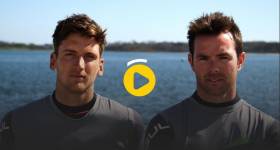Displaying items by tag: Olympic 49er
With Palma in the Balance, Hopes Are That Final Olympic 49er Berths for Tokyo Can Be Settled on the Water
The hope is that racing will decide the final Olympic berths in the 49er class in which Ireland is one of four countries hoping to progress to Tokyo but uncertainty surrounds this as COVID threatens to cancel the Princesa Trofeo Sofia qualification regatta in Palma de Mallorca, now just 56 days away.
Ireland is vying with Belgium, Sweden and Italy for the one remaining European place. Ryan Seaton and Seafra Guilfoyle and Robert Dickson and Sean Waddilove both chasing the elusive Olympic place for Ireland. Form at the 2020 Worlds suggested that Irish sailors would be favourites having finished ahead of the other three candidates.
Palma 2021 decision
Insiders are saying a decision on Palma is expected next week as organisers on the Spanish island look at options to separate the fleets into two shifts per day in order to keep a maximum number of sailors below the limit Spain sets for gatherings but that's easier said than done at a regatta that regularly attracts 1500 sailors from 30 countries or more.
Already the Abu Dhabi qualifier for the Asia and African qualification is cancelled and participants there say efforts are being made to see if Oman can host an alternative regatta in March.
In Europe, if Palma is cancelled there is no 'Plan B' as such, other than to try and redesignate the Olympic qualifier at France's Hyeres Regatta in April or the 49er European Championships in Greece, just two months ahead of the Games itself.
Historical results
If all that fails, World Sailing has said it will rely on historical results to decide the final berths as Afloat previously reported here.
It's all a long way from where everyone hoped they would be in 2021 in this fight against the pandemic.
Olympic sailors Ryan Seaton and Matthew McGovern starred in last night's RTE Rio Olympic preview series. The pair sailing in the high–speed 49er skiff class and secured an Olympic spot with a top 10 finish at the 2014 World Championships. But as they reveal in the programme funding issues mean that their preparations for the Olympics are anything but smooth. Check out the programme here
























